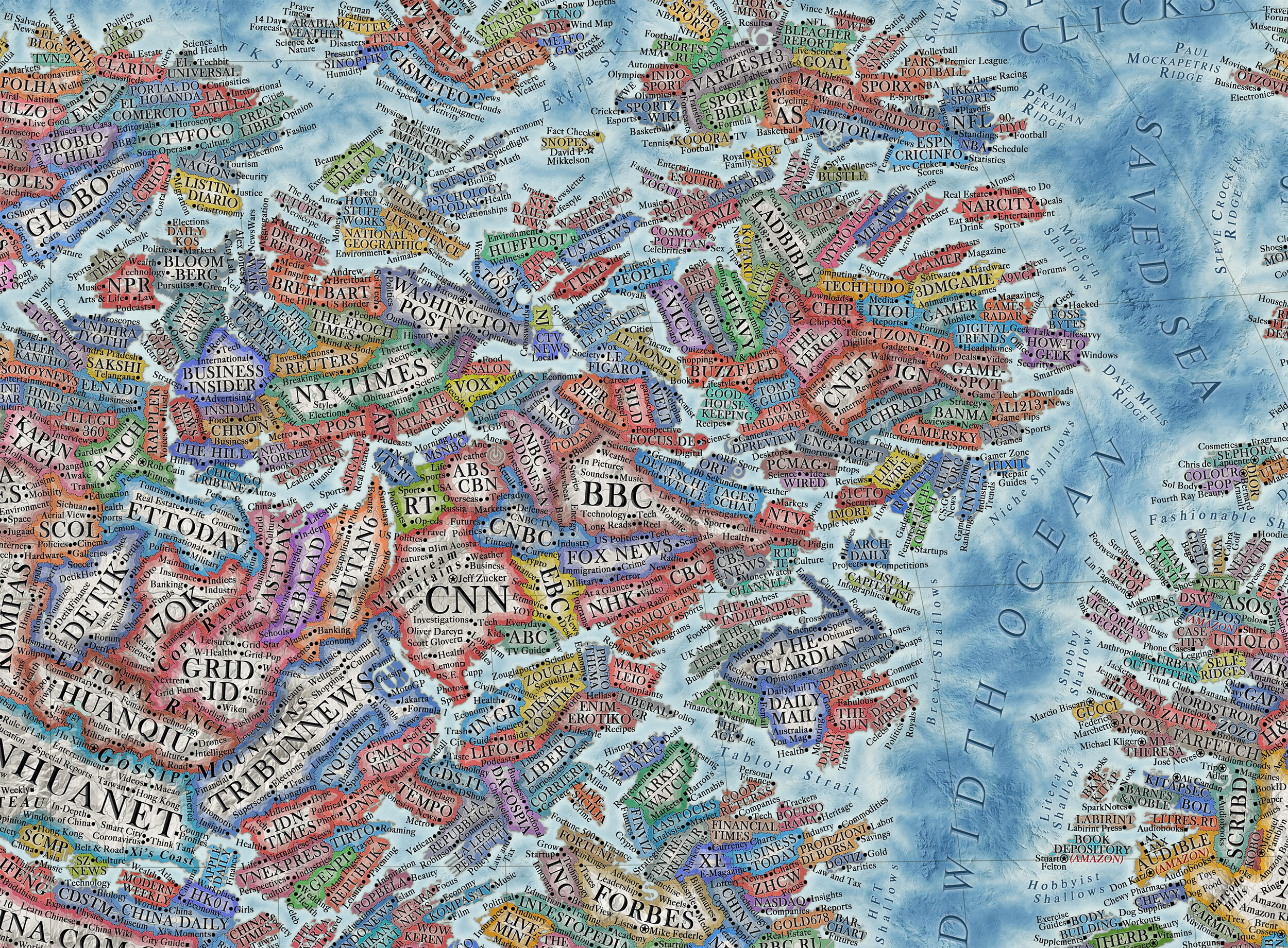Map of the Internet 2021
SEE THE MAP IN A HIGH RESOLUTION HERE!
Exclusive high quality posters available on titan-maps.com!
After a better part of a year of work, I am excited to show you a brand new Map of the Internet, up to date for the year 2021.
Inspired by design of historical maps, this project aims to concisely, but still comprehensively visualize the current state of the World Wide Web, and document the largest and most popular websites over the period of 2020-2021, along with their countless aspects and features.
Compared to any previous iteration of the Map of the Internet, this new version is many times more detailed and informative. It includes several thousand of some of the most popular websites, represented as distinct "countries", which are grouped together with others of similar type or category, forming dozens of distinct clusters, regions and continents that stretch throughout the map, such as "news sites", "search engines", "social networks", "e-commerce", "adult entertainment", "file sharing", "software companies" and so much more. In the center of it all can be found ISPs and web browsers, which form the core and backbone of the internet as we know it, while the far south is the domain of the mysterious "dark web".
Color schemes of websites are based on the dominant colors of their user interface or logo. To add further detail and provide deeper insight, many features and services provided by these websites, their sections and content categories, as well as distinct content creators, are labeled as cities and towns (which number at well over 10 thousand). Website founders and CEOs are represented as capital cities, while hundreds of the most popular users of social networks and celebrities can be found in the realms of Youtube, Facebook, or Twitter. Mountains, hills, seas and valleys represent a wide variety of aspects of the internet, its culture and computer science overall, while almost a hundred of some of the most important internet and computing pioneers are also featured on the map in the names of underwater ridges.
Surrounding the main map, the graphic also includes a large amount of supplemental information, including a ranking of the most popular websites, largest internet-related companies, list of major sites blocked in China or best-selling video games of all time, as well as several smaller maps of the real world, on internet-related topics, such as the share of population using the internet, cost and speed of broadband, levels of internet censorship and the most popular social network by country.
Relative territorial sizes of websites on the main map are based on their average Alexa web traffic ranking between January 2020 and January 2021. In the coming years, the relative popularity of sites bound to gradually change, some of the old sites will be shut down as new sites take their place, so this map can provide an unprecedented visualization to the future generations of how internet used to be.
Since its inception in 1989, the internet has been in a state of continuous flux as millions of different sites emerged and then fell by the wayside. From this initial chaos, many major corporate players have emerged over the decades, and have since become dominant in heir respective niches. This trend has been especially evident in the last decade, as Google, Youtube, Amazon and Facebook have far outgrown or absorbed most of their previous competition on an international global scale. Increasingly, this has led to mounting accusations of monopolistic behavior, censorship and misuse of user data.
Many countries still have many thriving domestic sites and social networks specific to their region, including Iran, Russia, Japan, India, Indonesia ,South Korea, but especially China.
In the last decade, Chinese internet userbase has grown rapidly, and as most major international sites such as Google, Youtube and Facebook are blocked by the government, China has developed an independent domestic ecosystem of websites of all types, such as Weibo, Baidu, Tmall and QQ, some of which have grown to rival even such sites as Google or Facebook in their sheer number of visitors and activity. However their presence outside of mainland China is almost nonexistent, mostly for linguistic and cultural reasons.
This work was originally inspired by the “Map of Online Communities“ by Randall Munroe, and further by my own maps of the internet 1.0, 2.0 and 3.0 previously published in 2014-2015.




